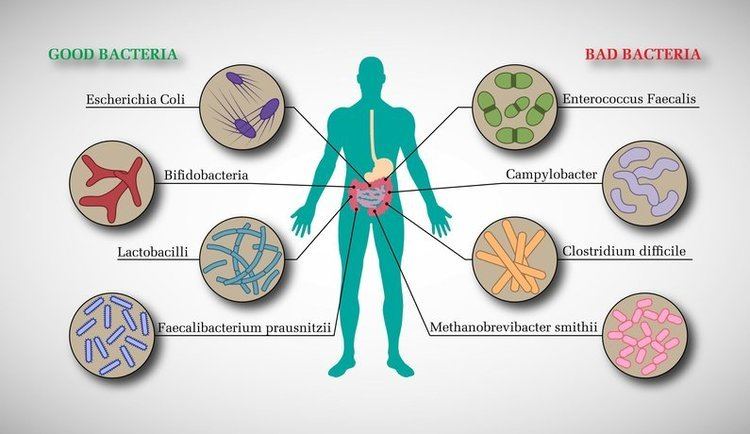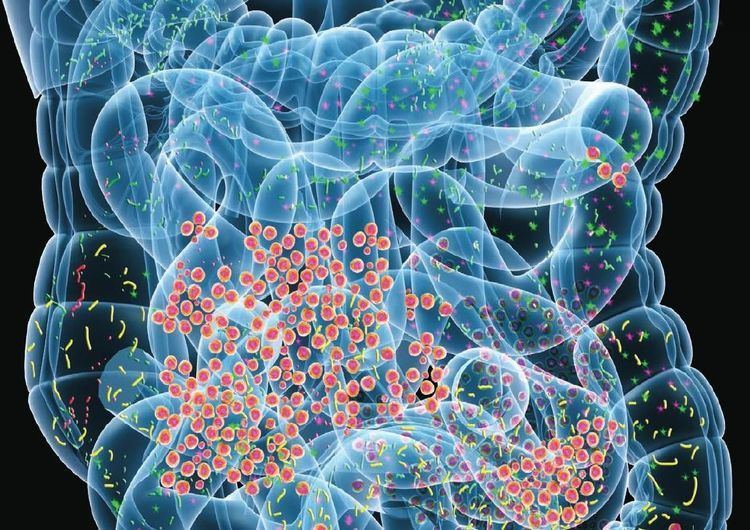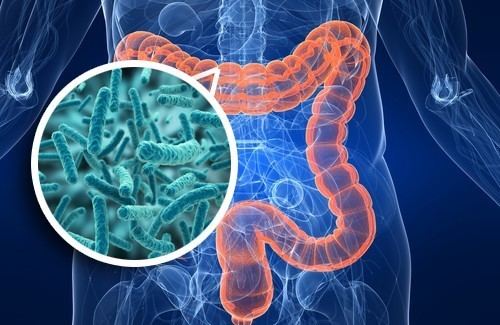 | ||
What gut microbes can tell us rob knight
A microbiota is an "ecological community of commensal, symbiotic and pathogenic microorganisms" found in and on all multicellular organisms studied to date from plants to animals. A microbiota includes bacteria, archaea, protists, fungi and viruses. Microbiota have been found to be crucial for immunologic, hormonal and metabolic homeostasis of their host. The synonymous term microbiome describes either the collective genomes of the microorganisms that reside in an environmental niche or the microorganisms themselves.
Contents
- What gut microbes can tell us rob knight
- How nutrition can shape gut microbiota alessio fasano march 2016
- Introduction
- Types of host relationships
- Acquisition and change
- Microbiota by host
- Humans
- Non human animals
- Plants
- Functions
- Immune system
- Endocrine system
- Metabolism
- Co evolution of microbiota
- Targeted amplicon sequencing
- Metagenomic sequencing
- RNA and protein based approaches
- Projects
- Privacy issues
- References

The microbiome and host emerged during evolution as a synergistic unit from epigenetics and genomic characteristics, sometimes collectively referred to as a holobiont.

How nutrition can shape gut microbiota alessio fasano march 2016
Introduction

All plants and animals, from protists to humans, live in close association with microbial organisms (see for example the human microbiome). Up until relatively recently, however, biologists have defined the interactions of plants and animals with the microbial world mostly in the context of disease states and of a relatively small number of symbiotic case studies. Organisms do not live in isolation but have evolved in the context of complex communities. A number of advances have driven a change in the perception of microbiomes, including:

Increasingly, biologists have come to appreciate that microbes make up an important part of an organism's phenotype, far beyond the occasional symbiotic case study.
Types of host relationships
Commensalism, a concept developed by Pierre-Joseph van Beneden (1809-1894), a Belgian professor at the University of Louvain during the nineteenth century is central to the microbiome, where microbiota colonize a host in a non-harmful coexistence. The relationship with their host is called mutualistic when organisms perform tasks that are known to be useful for the host, parasitic, when disadvantageous to the host. Other authors define a situation as mutualistic where both benefit, and commensal, where the unaffected host benefits the symbiont. A nutrient exchange may be bidirectional or unidirectional, may be context dependent and may occur in diverse ways. Microbiota that are expected to be present, and that under normal circumstances do not cause disease, are deemed normal flora or normal microbiota.
Acquisition and change
The Initial acquisition of microbiota in animals from mammalians to marine sponges is at birth, and may even occur through the germ cell line. In plants, the colonizing process can be initiated below ground in the root zone, around the germinating seed, the spermosphere, or originate from the above ground parts, the phyllosphere and the flower zone or anthosphere. The stability of the rhizosphere microbiota over generations depends upon the plant type but even more on the soil composition, i.e. living and non living environment.
Microbiota by host
Consensus exists among evolutionary biologists that one should not separate an organism's genes from the context of its resident microbes.
Humans
The human microbiota includes bacteria, fungi, archaea and viruses. Micro-animals which live on the human body are excluded. The human microbiome refers to their genomes.
Humans are colonized by many microorganisms; the traditional estimate was that humans live with ten times more non-human cells than human cells; more recent estimates have lowered this to 3:1 and even to about 1:1.
The Human Microbiome Project sequenced the genome of the human microbiota, focusing particularly on the microbiota that normally inhabit the skin, mouth, nose, digestive tract, and vagina. It reached a milestone in 2012 when it published initial results.
Non-human animals
Plants
Functions
Microbiota have been found to be crucial for immunologic, hormonal and metabolic homeostasis of their host.
Immune system
The symbiotic relationship between a host and its microbiota shapes the immune system of mammalians, insects, plants and aquatic organisms. In many animals, the immune system and microbiota engage in "cross-talk", exchanging chemical signals. This allows the immune system to recognize the types of bacteria that are harmful to the host and combat them, while allowing the helpful bacteria to carry out their functions; in turn, the microbiota influence immune reactivity and targeting. Bacteria can be transferred from mother to child through direct contact and after birth, or through indirect contact through eggs, coprophagy, and several other pathways. As the infant microbiome is established, commensal bacteria quickly populate the gut, prompting a range of immune responses and "programming" the immune system with long-lasting effects. The bacteria are able to stimulate lymphoid tissue associated with the gut mucosa, which enables the tissue to produce antibodies for pathogens that may enter the gut.
The human microbiome plays a role in the activation of toll-like receptors (TLRs) in the intestines, a type of pattern recognition receptor host cells use to recognize dangers and repair damage. Pathogens can influence this coexistence leading to immune dysregulation including and susceptibility to diseases, immune tolerance and autoimmune diseases.
Endocrine system
Intestinal microbiota can interact with thyroid-related micronutrients and the metabolism of endogenous iodothyronines such as Triiodothyronine and exogenous iodothyronines, which affects even phyla without thyroid follicles, such as jellyfish, insects, and sea urchins, as iodothyronine-induced metamorphosis is an ancestral feature of all chordates.
Microbiota can affect a fruit fly´s sex preference in mating. Infecting flies with pure cultures of Lactobacillus plantarum established a certain mating preference as L. plantarum can change the fly´s levels of cuticular hydrocarbon sex pheromones.
Metabolism
When adult germ-free mice are colonized with the gut flora of obese mice, they can gain weight dramatically with an increased metabolism of monosaccharides and short-chain fatty acids. The gut flora of obese mice has less Bacteroidetes than Firmicutes and is thought to be more efficient at extracting energy from food.
Co-evolution of microbiota
Organisms evolve within eco-systems so that the change of one organism affects the change of others. Co-evolution (also called "hologenome theory") proposes that an object of natural selection is not the individual organism, but the organism together with its associated organisms, including its microbial communities.
Coral reefs. The hologenome theory originated in studies on coral reefs. Coral reefs are the largest structures created by living organisms, and contain abundant and highly complex microbial communities. Over the past several decades, major declines in coral populations have occurred. Climate change, water pollution and over-fishing are three stress factors that have been described as leading to disease susceptibility. Over twenty different coral diseases have been described, but of these, only a handful have had their causative agents isolated and characterized. Coral bleaching is the most serious of these diseases. In the Mediterranean Sea, the bleaching of Oculina patagonica was first described in 1994 and shortly determined to be due to infection by Vibrio shiloi. From 1994 to 2002, bacterial bleaching of O. patagonica occurred every summer in the eastern Mediterranean. Surprisingly, however, after 2003, O. patagonica in the eastern Mediterranean has been resistant to V. shiloi infection, although other diseases still cause bleaching. The surprise stems from the knowledge that corals are long lived, with lifespans on the order of decades, and do not have adaptive immune systems. Their innate immune systems do not produce antibodies, and they should seemingly not be able to respond to new challenges except over evolutionary time scales.
The puzzle of how corals managed to acquire resistance to a specific pathogen led to a 2007 proposal, that a dynamic relationship exists between corals and their symbiotic microbial communities. It is thought that by altering its composition, the holobiont can adapt to changing environmental conditions far more rapidly than by genetic mutation and selection alone. Extrapolating this hypothesis to other organisms, including higher plants and animals, led to the proposal of the "hologenome theory of evolution".
As of 2007 the hologenome theory was still being debated. A major criticism has been the claim that V. shiloi was misidentified as the causative agent of coral bleaching, and that its presence in bleached O. patagonica was simply that of opportunistic colonization. If this is true, the basic observation leading to the theory would be invalid. The theory has gained significant popularity as a way of explaining rapid changes in adaptation that cannot otherwise be explained by traditional mechanisms of natural selection. Within the hologenome theory, the holobiont has not only become the principal unit of natural selection but also the result of other step of integration that it is also observed at the cell (symbiogenesis, endosymbiosis) and genomic levels.
Targeted amplicon sequencing
Targeted amplicon sequencing relies on having some expectations about the composition of the community that is being studied. In target amplicon sequencing a phylogenetically informative marker is targeted for sequencing. Such a marker should be present in ideally all the expected organisms. It should also evolve in such a way that it is conserved enough that primers can target genes from a wide range of organisms while evolving quickly enough to allow for finer resolution at the taxonomic level. A common marker for human microbiome studies is the gene for bacterial 16S rRNA (i.e. "16S rDNA", the sequence of DNA which encodes the ribosomal RNA molecule). Since ribosomes are present in all living organisms, using 16S rDNA allows for DNA to be amplified from many more organisms than if another marker were used. The 16S rDNA gene contains both slowly evolving regions and fast evolving regions; the former can be used to design broad primers while the latter allow for finer taxonomic distinction. However, species-level resolution is not typically possible using the 16S rDNA. Primer selection is an important step, as anything that cannot be targeted by the primer will not be amplified and thus will not be detected. Different sets of primers have been shown to amplify different taxonomic groups due to sequence variation.
Targeted studies of eukaryotic and viral communities are limited and subject to the challenge of excluding host DNA from amplification and the reduced eukaryotic and viral biomass in the human microbiome.
After the amplicons are sequenced, molecular phylogenetic methods are used to infer the composition of the microbial community. This is done by clustering the amplicons into operational taxonomic units (OTUs) and inferring phylogenetic relationships between the sequences. Due to the complexity of the data, distance measures such as UniFrac distances are usually defined between microbiome samples, and downstream multivariate methods are carried out on the distance matrices. An important point is that the scale of data is extensive, and further approaches must be taken to identify patterns from the available information. Tools used to analyze the data include VAMPS, QIIME and mothur.
Metagenomic sequencing
Metagenomics is also used extensively for studying microbial communities. In metagenomic sequencing, DNA is recovered directly from environmental samples in an untargeted manner with the goal of obtaining an unbiased sample from all genes of all members of the community. Recent studies use shotgun Sanger sequencing or pyrosequencing to recover the sequences of the reads. The reads can then be assembled into contigs. To determine the phylogenetic identity of a sequence, it is compared to available full genome sequences using methods such as BLAST. One drawback of this approach is that many members of microbial communities do not have a representative sequenced genome.
Despite the fact that metagenomics is limited by the availability of reference sequences, one significant advantage of metagenomics over targeted amplicon sequencing is that metagenomics data can elucidate the functional potential of the community DNA. Targeted gene surveys cannot do this as they only reveal the phylogenetic relationship between the same gene from different organisms. Functional analysis is done by comparing the recovered sequences to databases of metagenomic annotations such as KEGG. The metabolic pathways that these genes are involved in can then be predicted with tools such as MG-RAST, CAMERA and IMG/M.
RNA and protein-based approaches
Metatranscriptomics studies have been performed to study the gene expression of microbial communities through methods such as the pyrosequencing of extracted RNA. Structure based studies have also identified non-coding RNAs (ncRNAs) such as ribozymes from microbiota. Metaproteomics is an approach that studies the proteins expressed by microbiota, giving insight into its functional potential.
Projects
The Human Microbiome Project launched in 2008 was a United States National Institutes of Health initiative to identify and characterize microorganisms found in both healthy and diseased humans. The five-year project, best characterized as a feasibility study with a budget of $115 million tested how changes in the human microbiome are associated with human health or disease.
The Earth Microbiome Project (EMP) is an initiative to collect natural samples and analyze the microbial community around the globe. Microbes are highly abundant, diverse and have an important role in the ecological system. Yet as of 2010, it was estimated that the total global environmental DNA sequencing effort had produced less than 1 percent of the total DNA found in a liter of seawater or a gram of soil, and the specific interactions between microbes are largely unknown. The EMP aims to process as many as 200,000 samples in different biomes, generating a complete database of microbes on earth to characterize environments and ecosystems by microbial composition and interaction. Using these data, new ecological and evolutionary theories can be proposed and tested.
The Brazilian Microbiome Project aims to assemble a Brazilian Microbiome Consortium/Database. This is the first attempt to collect and collate information about Brazilian microbial genetic and functional diversity in a systematic and holistic manner. New sequence data have been generated from samples collected in all Brazilian regions.
Privacy issues
Microbial DNA inhabiting a person's human body can uniquely identify the person. A person's privacy may be compromised if the person anonymously donated microbe DNA data. Their medical condition and identity could be revealed.
